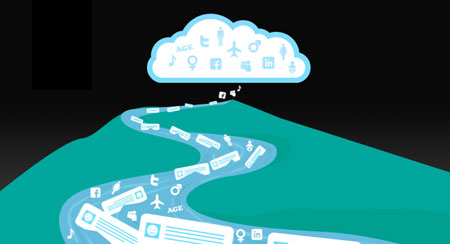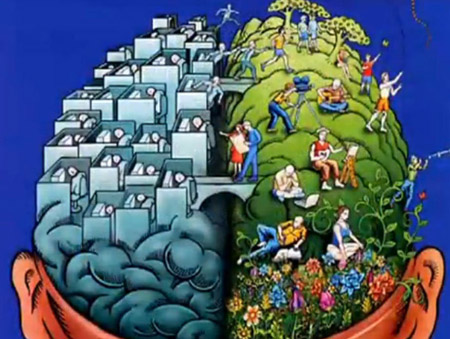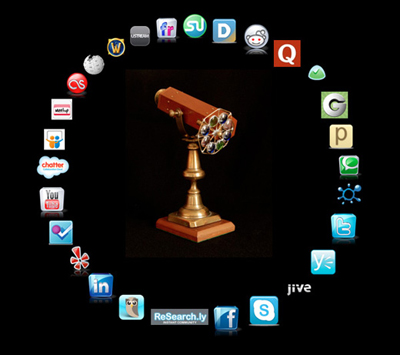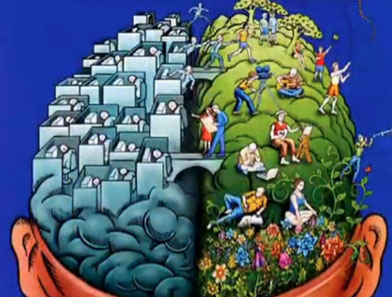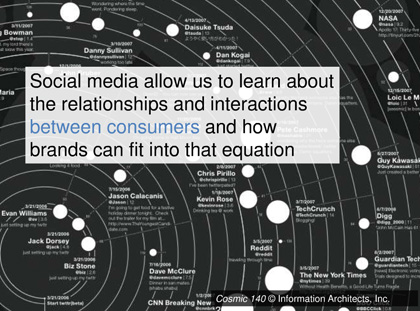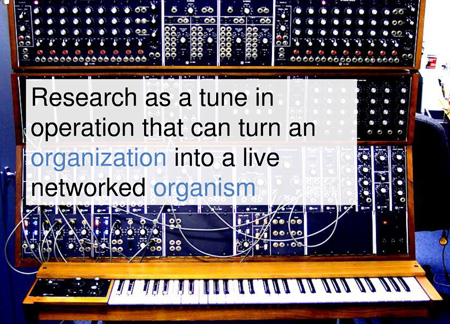“We have the conversations now…we don’t need Nielsen…we don’t really even need some of these deep analytics anymore…we have the conversations” ~Jodee Rich, CEO, PeopleBrowsr
“You need someone who can read into the data and say “this is telling me…” @richmeyer
“There are way too many analytic solutions out there & not enough people to analyze the data and turn it into action.” @richmeyer
“Organizations need individuals/teams within to leverage analytics into actionable items that can help meet brand objectives.” @richmeyer
“A “spot-on” CSV of 100 Key Influencers w/social links + a summation of these Influencers’ latest messages/social objects + a graph of who follows them and who they follow.” @Nat_Hansen
“We helped (this brand) find 10,000 followers who REALLY loved them and their click through rate went up significantly…it (stories, conversations, and numbers) absolutely become dollars when it becomes what people are really thinking about us.” ~Jodee Rich, CEO, PeopleBrowsr
MANAGERS AT AD AGENCIES ARE MORE INTERESTED IN THEIR BUSINESS MODEL & MONEY VS. HOW PEOPLE FEEL: Putting a brand-oriented organization like an ad agency in charge of nurturing a community of people within social networks is a mistake. An ad agency’s business model is based on revenues earned from media. They create broadcast messaging for broadcast media. The growth of vibrant social communities is better done by those from WITHIN those same communities, individuals committed to the core values of whatever that particular circle lives for.
If a community is only nurtured for transactional purposes, its members interact differently than if the community has been formed around a passion, a shared interest. Good content-marketing is informed by deep insights derived from conversation snippets within social networks. And most brands and agencies are not staffed with the right people to discover such insights. They are smart but they are bound to their business model.
The best organization to build a social community consists of those who care about and have “grown up” within that community itself…whether it be the community OF THE BRAND ITSELF or a non-branded community that is GENRE-SPECIFIC (in which a particular brand tends to flourish). Additionally, those familiar with social networks and how to use social technologies are the best to train these community leaders. To sum up: Orient towards those who care about people as the ones to initiate AND grow a community within social networks.
SOCIAL PSYCHOLOGY IS A TOP PRIORITY IN COMMUNITY CREATION: A number of organizations I am working with now in Europe are dealing with this exact issue. The ad agency for these organizations has been in charge of informing the ethos of the customer-facing materials. But now, in both cases, it turns out that the budding communities forming around these brands need leadership and nurturing. And there is no-one managing the brand or on staff at the agency that truly cares about the quality of the community. The PRIMARY discussion is: how many Likes can we get AND how many of those Likes can we turn into dollars or euros? At the outset of growing social communities, such strong focus on growing Likes and turning Likes into dollars/euros can suffocate the organic growth of a circle of people simply coming together to share a common interest or passion. To sum up: Peter Ecomonomides of FelixBNI says, “social psychology is far more important than economics”.
SCALES OF CARE: I remember consulting to a large sales organization years ago in America. I worked with an I/O Psychologist to assess the 100 person staff within the organization as part of an HR project. The study yielded some interesting results. Of particular interest was the psychological make-up of the COO and the Director of Sales. The tests we were using showed, as one scale of measurement, an individual’s care for other humans…that is, how much concern someone had for another person and their feelings/needs. The COO and the Director of Sales scored 1 and 2 respectively on a 100 point scale, with 100 marking deep care for others. To sum up: Do NOT put Directors of Sales or CFOs in charge of policies related to social communities. This is the vicinity of those in Customer Experience and the customer journey.
Choosing Fun in relation to Key Influencers within the Interest Graph can be very effective. Check out this twitter campaign for a cell phone company in Turkey. Brilliant! Thanks to @helena_chari in Athens for turning me on to this!!
BE CUSTOMER-CENTRIC, NOT PRODUCT-CENTRIC: While it is true that not all COOs or Sales Directors globally might score in the same way, this example points to an important issue for those building social communities. Often the decision-makers in the room at enterprise-level organizations are the CFO (who influences the CEO) and leaders from the Sales division. On one level this makes sense since sales is the life-blood of most organizations and the CFO is the “dutch uncle” (ideally) who maintains efficiency and the books. But a CFO and a Director of Sales are NOT the right people to nurture a social community for a brand, nor to dictate how such a community ought to be created and populated. This is best done by individuals who understand customer-service, who care passionately about user-experience and who have a bias towards giving power to the customer in such forums. And that’s why large organizations globally are gearing more resources towards Chief Customer Officers vs. Chief Marketing Officers. See Harvard Business Review article on this subject here AND here.
STAFFING FOR CONVERSATION ANALYSIS: I recently interviewed a large interactive agency in a major European city. I was particularly interested in discovering to what extent the agency analyzed customer data for the purpose of deriving insight. In other words, aside from receiving metrics and analytics from a social monitoring solution, did the agency employ OR contract with individuals who studied conversations by influencers around a brand. And, if so, what training or background did those individuals have. It turned out that the tool the agency was using showed communities around interests related to a brand along with stats on those who occupied the communities BUT the agency had allocated no resources or staffing toward peering into the conversations. To sum up: agencies and brands MUST staff in relation to customer need vs. product need. Social communities are best served by those who understand the human heart.
ANALYSIS OF CONVERSATION AND STORYTELLING: Something very powerful emerges when one knows what others are interested in talking about. Consider for a moment how powerful it would be for that interactive agency to spend time looking at the last 100 tweets/status updates/blog posts/thread comments OF the top 100 online influencers around its customers’ products. And what if the person studying this messaging had a background in psychology, writing psychological assessments and/or in journalism, feature stories. Agencies MUST consider contracting with or employing such people to do exactly this task. The creativity that emerged from the focus groups of old is amplified in potential with so many conversation snippets now discoverable within social networks around ANY topic. A psychologically-aware storyteller who understands the power of mashing-up content IS the individual ALL agencies and brands should be sending headhunters to find. Non-branded Twitter communities created on-the-fly for research purposes can be very powerful scopes for those with a trained eye and a trained heart. To sum up: Agencies and brands MUST hire individuals or contract to organizations who specialize in community and conversation analysis. Storytellers are vital to community conception and creation.
GOOD QUESTIONS TO ASK: Interactive and ad/marketing agencies should be asking themselves the following questions:
1. Are we satisfied with our process for deriving insight, customer intelligence and stories from our current social monitoring solution?
2. How much time are we spending on conversation/community analysis at the outset of social marketing projects? And on-going?
3. Have we considered hiring individuals trained in psychology and journalism to (a) analyze conversations within social communities and (b) create sticky content from the insights derived from these conversations?
4. Have we realized the full potential of non-branded Twitter communities as a valuable resource in gaining customer insight, gaining competitive intelligence and in our storytelling processes?
CONVERSATION INSIGHT AND ANALYSIS AT SLIDESHARE by THE SOCIALIZERS
RESOURCES:
Research.ly, a solution created by PeopleBrowsr, to create on-fly communities around ANY topic. This is an invaluable tool for market research and social community creation.
Copyblogger – a great resource for those who create content of all kinds.
Oxford Internet Institute Projects – this institute in the UK is deeply interested in the Hows and Whys of the Internet. The research they are doing is fantastic!
The Chief Customer Officer Council – The Chief Customer Officer Council is the first of its kind — a member-led peer-advisory network offering unparalleled insight into the critical issues facing CCOs.
WOMMA – Word of Mouth Marketing Organization – WOMMA is the premiere non-profit organization dedicated to advancing and advocating the discipline of credible word of mouth marketing, both offline and online.



